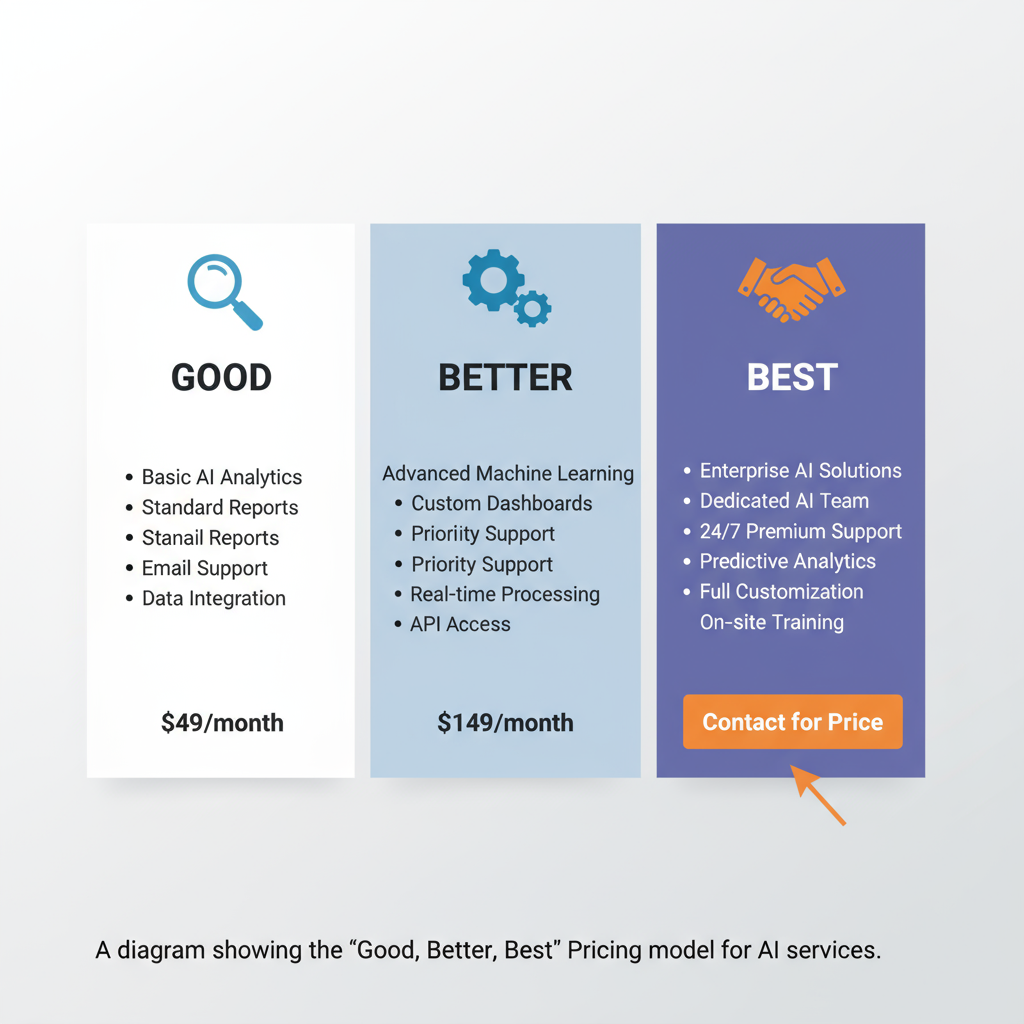Feeling the pressure to add "Prompt Engineer" to your title? You're not alone. But what if that popular label is actually holding you back? Chasing a buzzword title is a race to the bottom. Instead of just learning how to talk to an AI, let's focus on how to package that skill into a high-value service clients are desperate to buy. This guide will show you how to stop selling prompts and start selling outcomes.
Key Takeaways: Monetize Your AI Expertise
- Ditch the Title, Sell the Outcome: Learn why "AI Consultant" or "AI Systems Specialist" is more valuable than "Prompt Engineer" and how to frame your services around client results, not technical jargon.
- The Skill Pivot Framework: Discover how your existing skills as a marketer, writer, or designer are the perfect foundation for high-value AI services. No need to start from scratch.
- Productize Your Offering: We'll give you a clear "Good, Better, Best" model to package your services, making them easier for clients to understand and purchase.
- Find and Attract the Right Clients: Uncover the types of clients who are actively looking for AI-powered solutions and learn how to position yourself as the go-to expert.
- Build a Compelling Portfolio: See what a real AI service portfolio looks like, focusing on case studies and measurable results rather than just a list of prompts.

Why "Prompt Engineer" is a Limiting—and Temporary—Job Title
Let's be honest. "Prompt engineering" is just a transitional term for learning how to use a new, powerful tool. A few years ago, we didn't have "Google Search Specialists." We had researchers and strategists who were experts at finding information. The same shift is happening now. The tool is the AI, but the real value is in the strategy and application.
Clients don't want to buy prompts. They want to buy solutions. They have business problems: inefficient workflows, inconsistent brand voice, or a lack of creative ideas. Your job isn't to sell them a well-worded question; it's to sell them an entire system that solves their problem.
Before: A freelance writer sells "blog post writing" for $500. They spend 8 hours writing and researching.
After: The same writer now sells an "AI-Powered Content Engine" package for $2,000. This includes topic clustering using Perplexity AI, generating draft outlines with Claude 3, and refining the final articles to perfection. They deliver higher quality, more strategic content in half the time.
The AI Service Framework: From Skill to Scalable Offer
Ready to turn your skills into a structured service? Don't just offer "AI help." Build a clear, repeatable system that delivers predictable results. This framework helps you audit your existing skills, package them, and price them effectively.
Step 1: Audit & Identify Your Core Competency
What are you already great at? The goal isn't to become a generic AI expert, but to amplify your current expertise with AI. Map your skills to a specific AI application.
- If you're a Marketer: Your service isn't "prompt writing." It's "AI-Accelerated Market Research" using tools like Perplexity AI to synthesize customer data and identify trends in minutes, not days.
- If you're a Writer: You offer "Brand Voice AI Development." You use ChatGPT-4 or Claude 3 to create a custom-trained style guide and prompt library that allows a client's entire team to write in a consistent voice.
- If you're a Designer: You sell "Rapid Creative Concepting." Use Midjourney or DALL-E 3 to generate dozens of visual directions for a campaign, turning a week-long process into a single workshop session.
Step 2: Structure Your Service Packages
Productizing your service makes it tangible. Clients can see exactly what they're getting and what it costs. Use a "Good, Better, Best" model to guide them.
- Good (Starter): An "AI Audit & Strategy Session." A one-off project where you analyze a client's workflow and deliver a roadmap for AI integration. (e.g., $1,500)
- Better (Core Offer): "The AI Content System." A done-for-you service where you build and implement a specific solution, like the Brand Voice AI Development mentioned earlier. (e.g., $4,000)
- Best (Premium): "AI Consultant Retainer." An ongoing partnership where you manage their AI systems, train their team, and continuously optimize their workflows. (e.g., $3,000/month)
Ready to Package Your AI Skills?
Don't just list your skills, sell your solutions. Use Livesume's Services Page builder to create a compelling offer that attracts high-value clients in minutes.
Step 3: Build Your Proof-of-Work Portfolio
A portfolio for AI services isn't a gallery of pretty prompts. It’s a collection of business case studies. For each project, you need to show the "before" and "after."
Before: The client's marketing team spent 20 hours per week manually analyzing customer feedback surveys.
After: You built an AI workflow using Claude 3 that automatically triages, categorizes, and summarizes feedback, reducing the time spent to just 2 hours per week and surfacing critical insights 90% faster.
Your portfolio should live on a clean, professional page that tells this story. A simple Professional Page can serve as the central hub for your case studies, service offerings, and contact information.

Finding Clients Who Need Your AI-Powered Services
Forget scouring job boards for "Prompt Engineer" roles. Your ideal clients are likely business owners and department heads who are "problem-aware" but not "solution-aware." They know they have an efficiency or creativity problem, but they don't know that AI is the solution.
You find them by:
- Joining industry-specific communities: Be the marketer in a marketing Slack group who explains how AI can supercharge competitor analysis.
- Content Marketing: Write about the problems you solve, not the tools you use. A blog post titled "How to Cut Your Content Research Time by 80%" will attract more clients than "My Favorite ChatGPT Prompts."
- Pivoting Existing Clients: Reach out to your current or past clients. Offer to do a free "AI Opportunity Audit" on one part of their business. Show them the value, then upsell them on a full project. This is often the fastest path to your first AI service-based revenue.
Frequently Asked Questions About Selling AI Services
How do I sell myself as a prompt engineer without using the title?
Frame yourself as a specialist in your domain who uses AI as a tool. Call yourself an "AI-Powered Marketing Strategist" or a "Creative AI Consultant." Focus your pitch on the business outcome (e.g., "I help e-commerce brands develop entire product launch campaigns in a week") rather than the technical skill.
What services can a prompt engineer offer?
Think bigger than just writing prompts. You can offer AI workflow automation, custom AI chatbot creation for customer service, AI-driven market research reports, brand voice development systems, creative concept generation, and AI-powered data analysis for business intelligence.
How do I find clients who need prompt engineering?
Look for businesses struggling with scale, efficiency, or creative bottlenecks. Small to mid-sized agencies, overloaded marketing departments, and fast-growing startups are prime candidates. They often lack the resources for a dedicated AI team but feel the pain of inefficient processes.
Is 'prompt engineer' a real job title?
Yes, it's a real title, but it's most common inside large tech companies focused on developing the AI models themselves. For the freelance market, it's a confusing and often undervalued term. You'll have more success and command higher rates by positioning yourself as a strategic consultant.
How much should I charge for prompt engineering services?
Don't charge by the prompt or by the hour. Price your services based on the value you create. If your AI system saves a company $10,000 a month in labor, charging $5,000 for the project is a no-brainer for the client. Anchor your pricing to the return on investment.
What's the difference between a prompt engineer and an AI consultant?
A prompt engineer is a technician focused on crafting the perfect input for an AI model. An AI consultant is a strategist who understands the business problem first and then designs an end-to-end solution that may involve AI, workflow changes, and team training. Consultants solve business problems; technicians perform tasks.
Turn Your Draft Skills Into a Hiring Signal
The opportunity in front of you is massive, but it won't last forever. The market is rewarding those who can translate technical AI capabilities into real business strategy. It's time to move beyond the buzzwords and start building a real, valuable service offering.
Here’s your action plan:
- Audit Your Skills: Identify your core expertise and one specific, high-value problem you can solve with AI.
- Create One Productized Offer: Define a single, clear service package with a set price and deliverables. Start with your "Better" offer.
- Build a Simple Services Page: Use a tool like the Livesume Services Page to clearly articulate your value proposition and make it easy for clients to hire you.
- Find One Pilot Client: Offer your new service to a previous client at a slight discount in exchange for a killer testimonial and case study.
Stop waiting for the perfect title to appear. The real value is in what you can do, not what you call yourself. Go build something valuable.